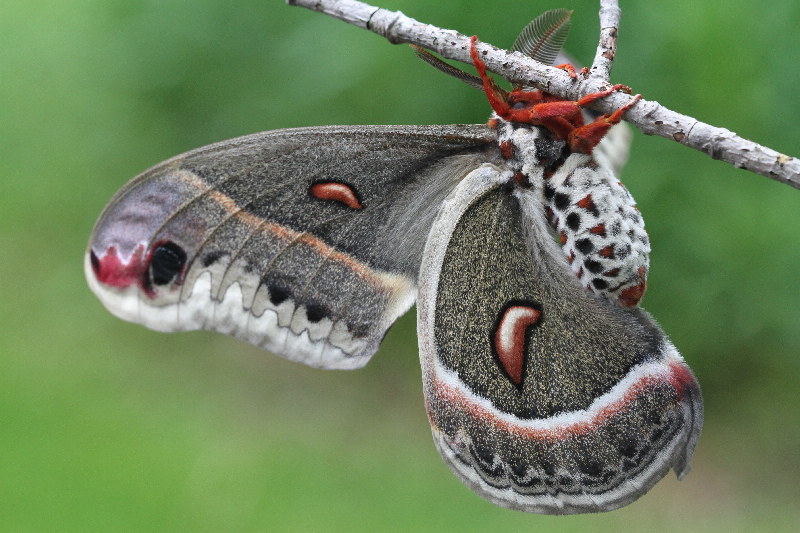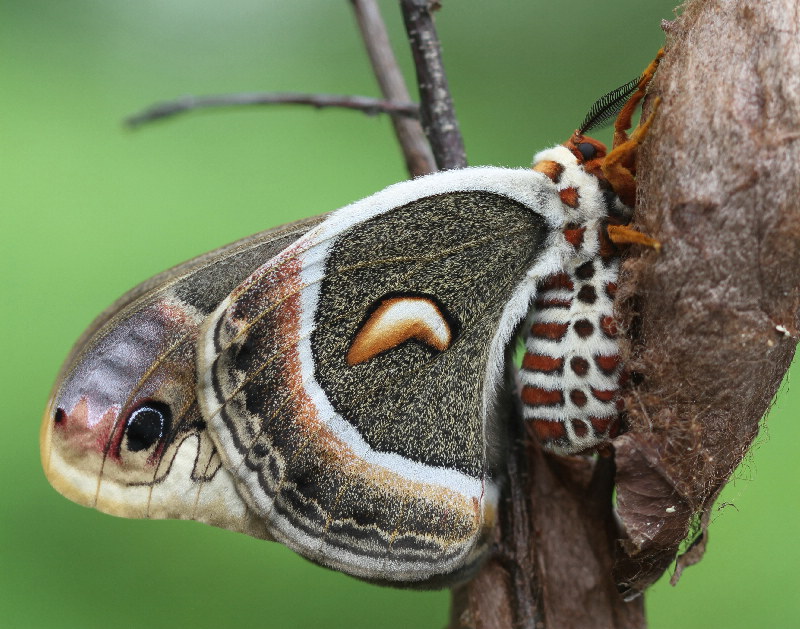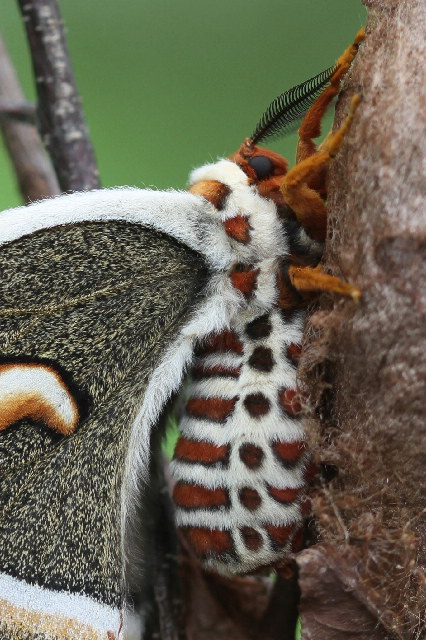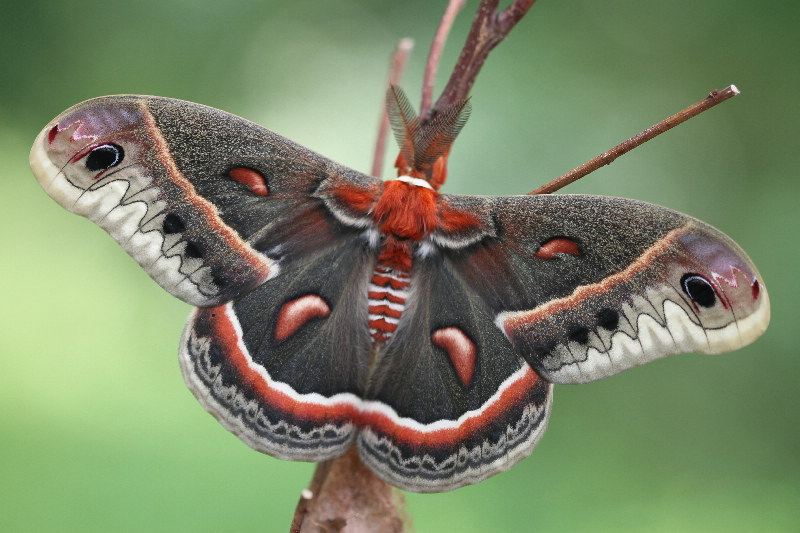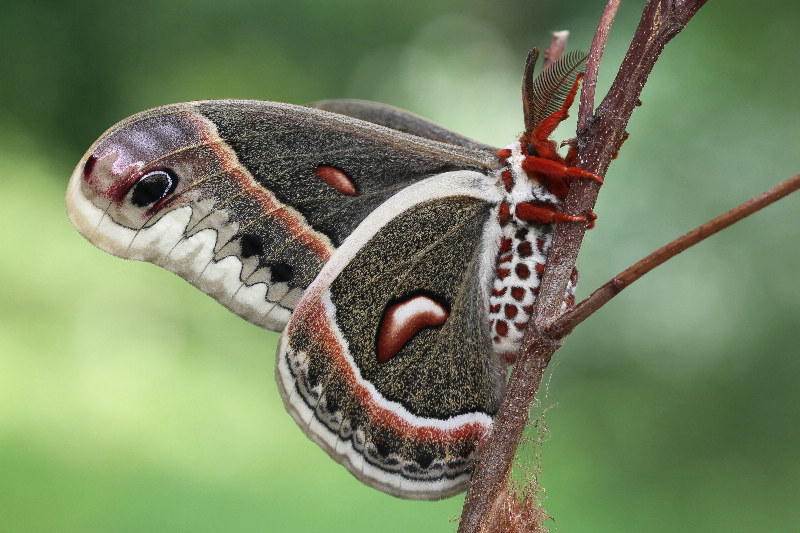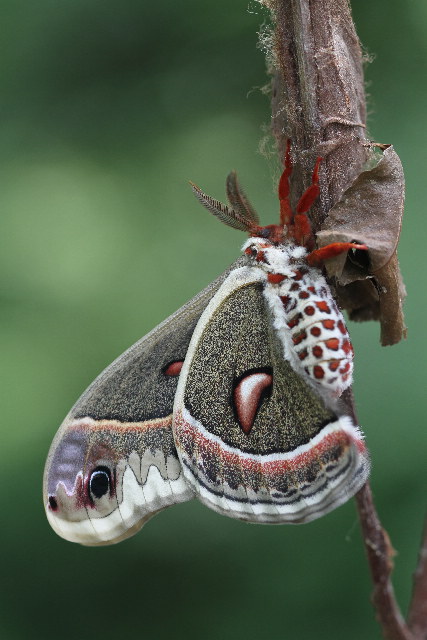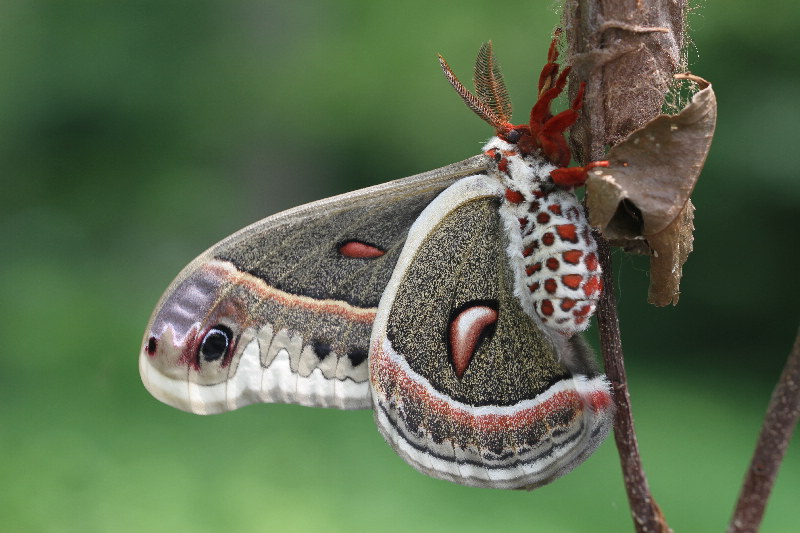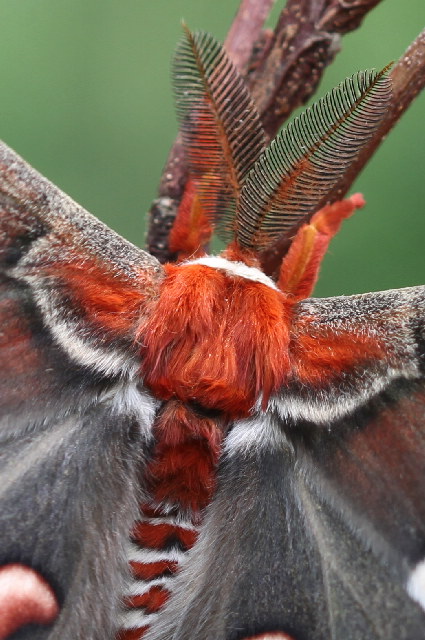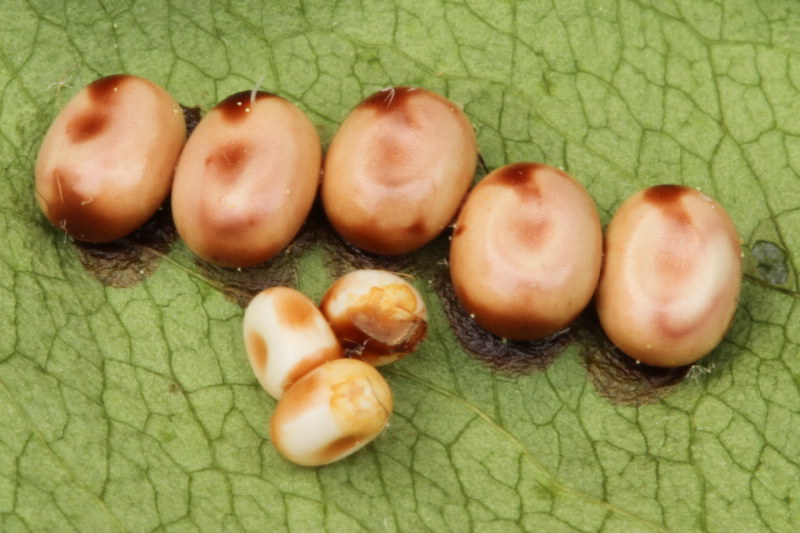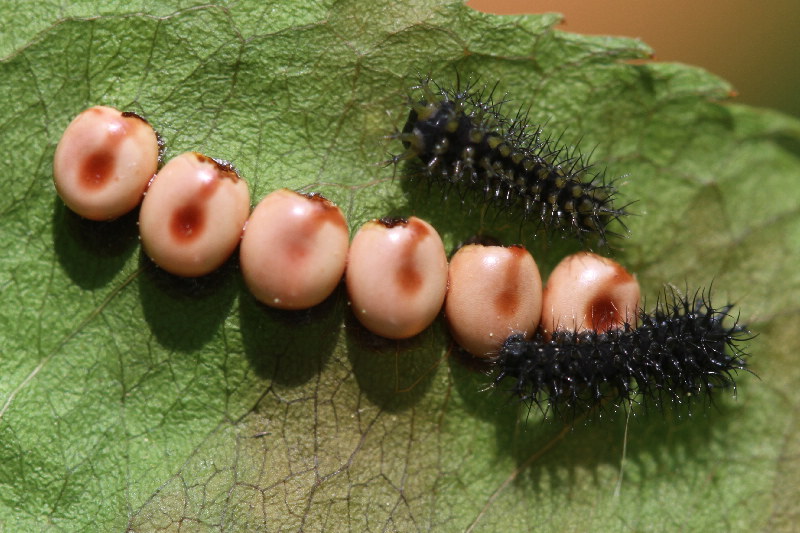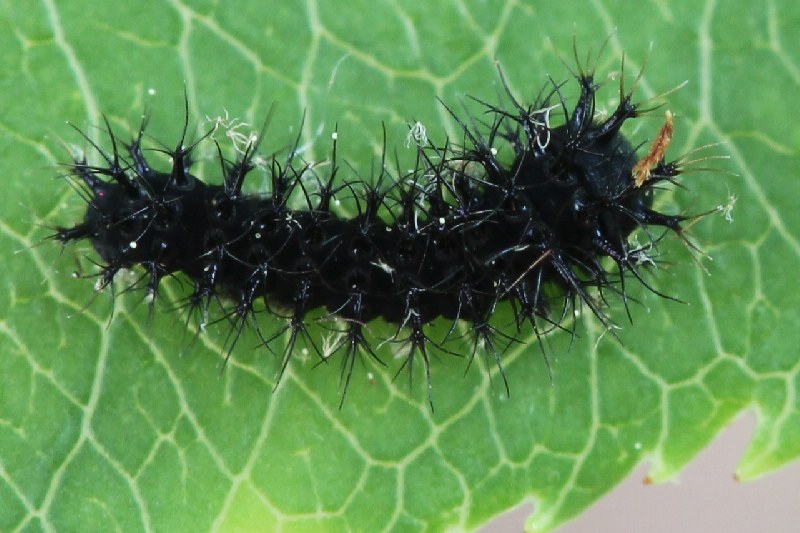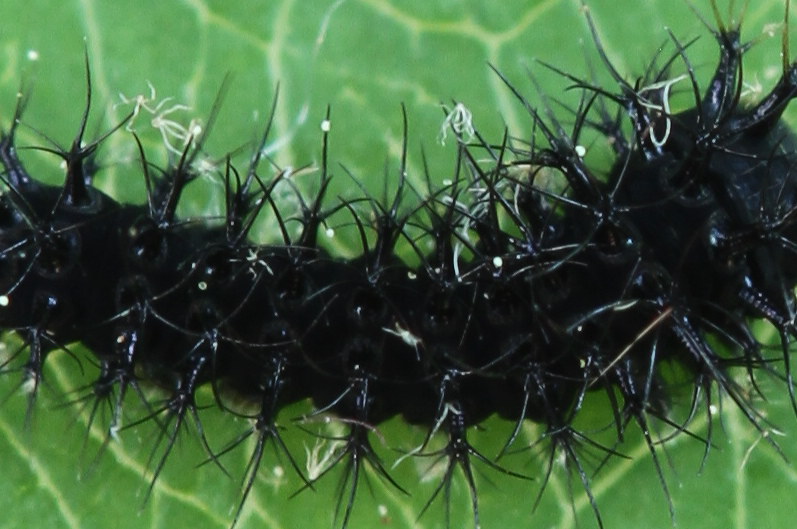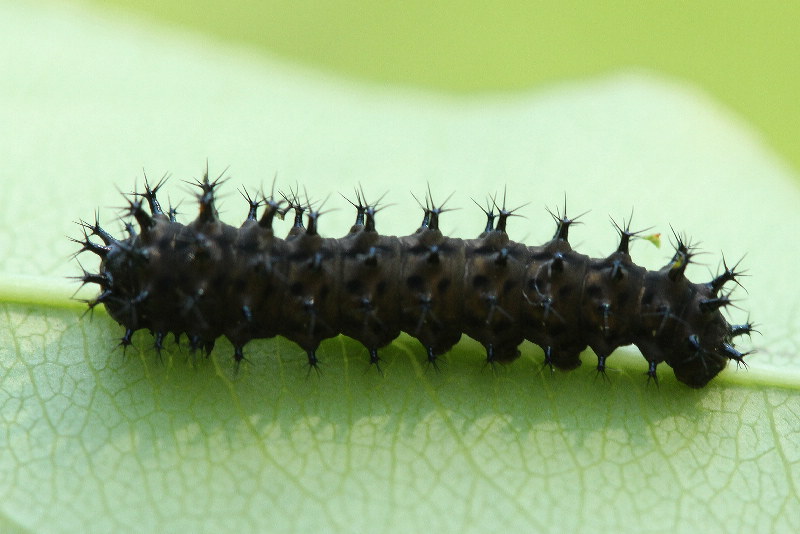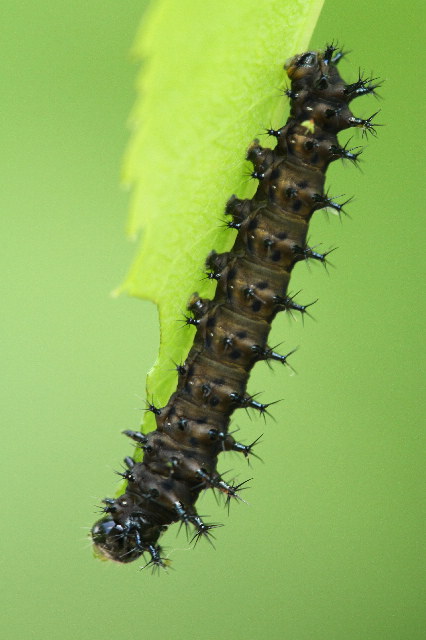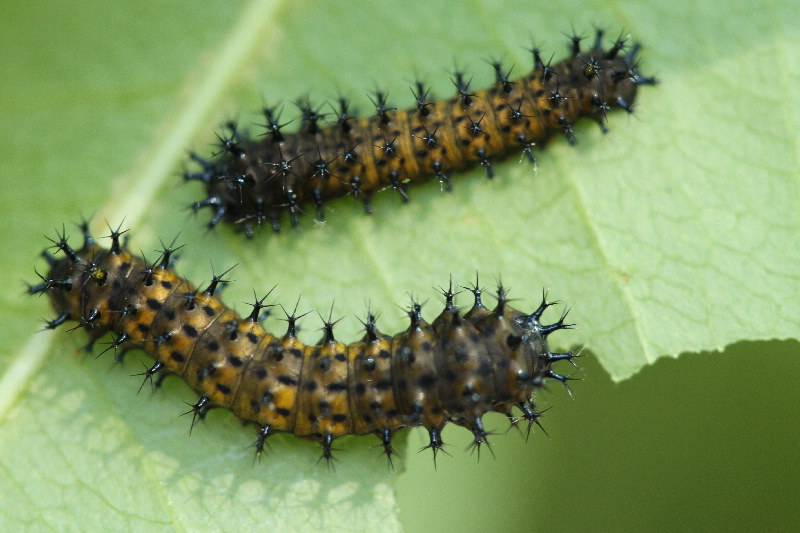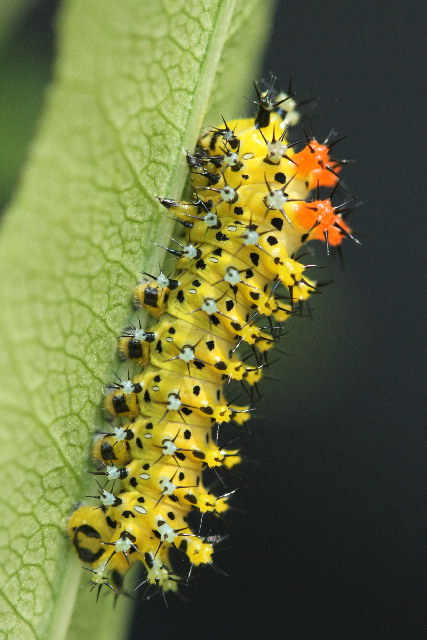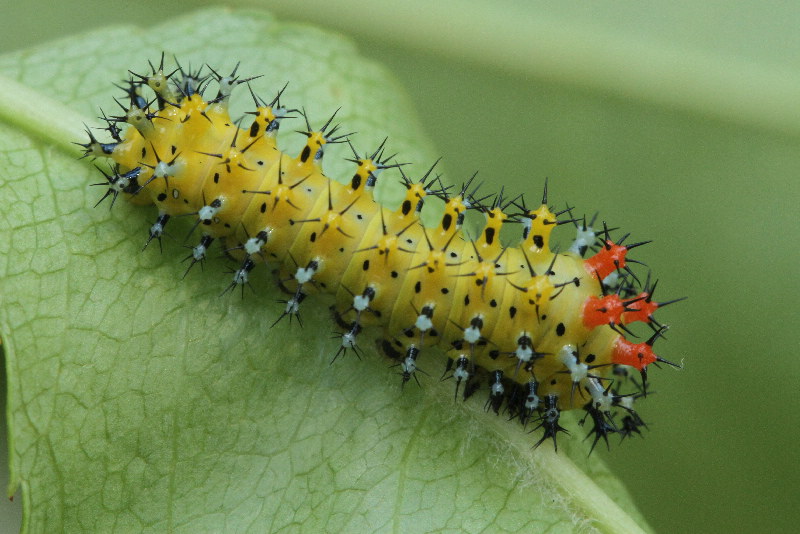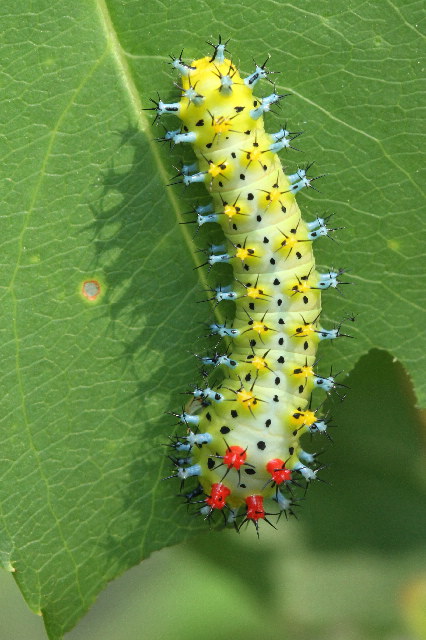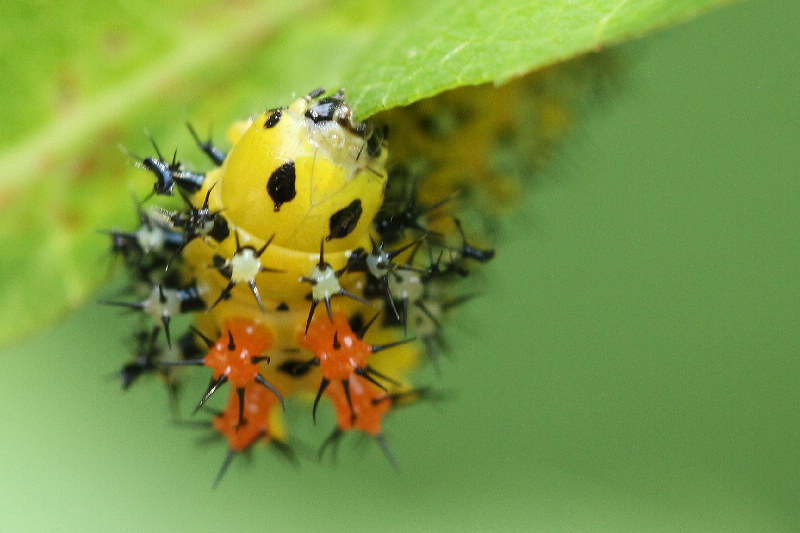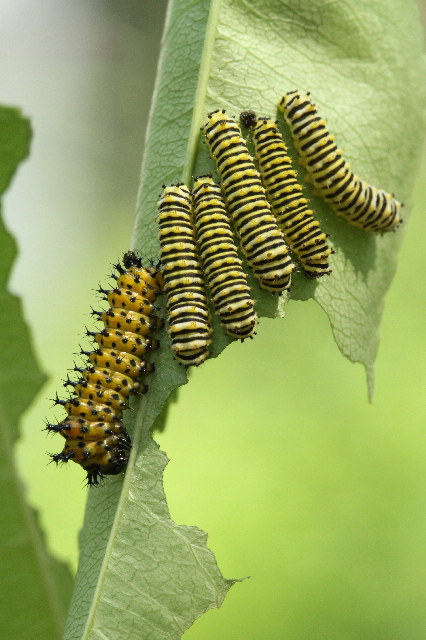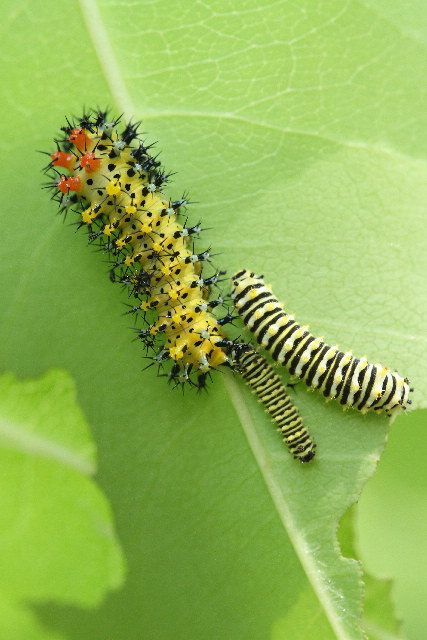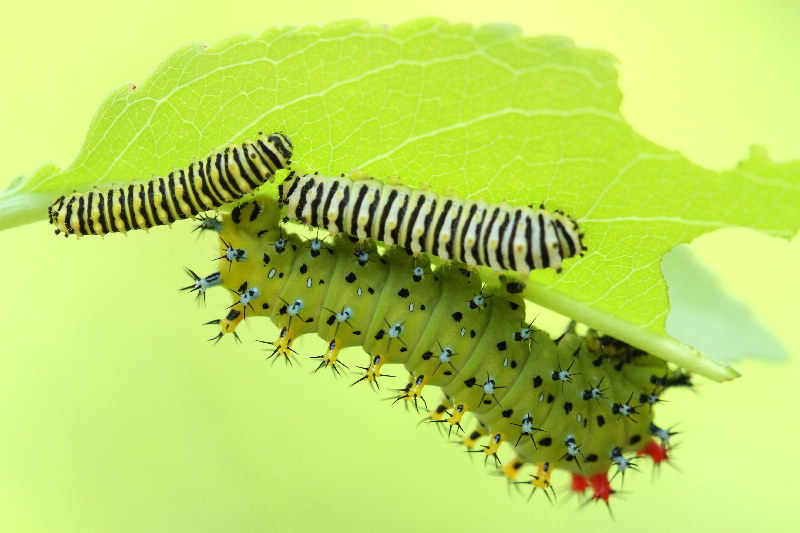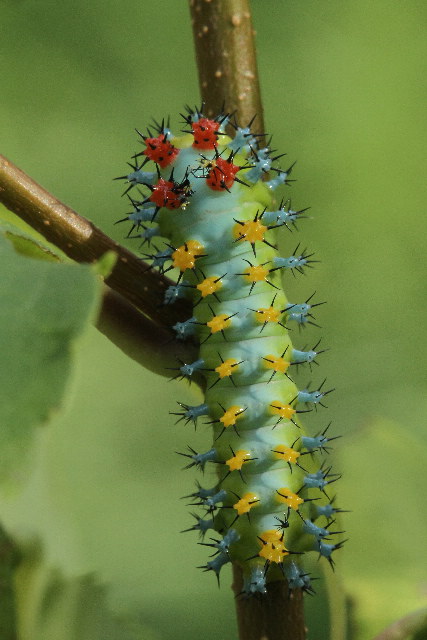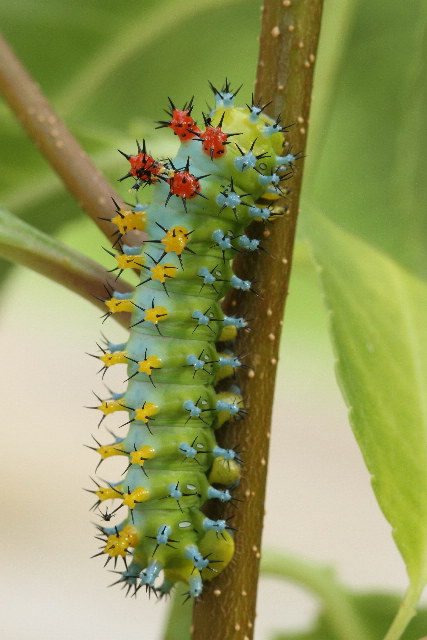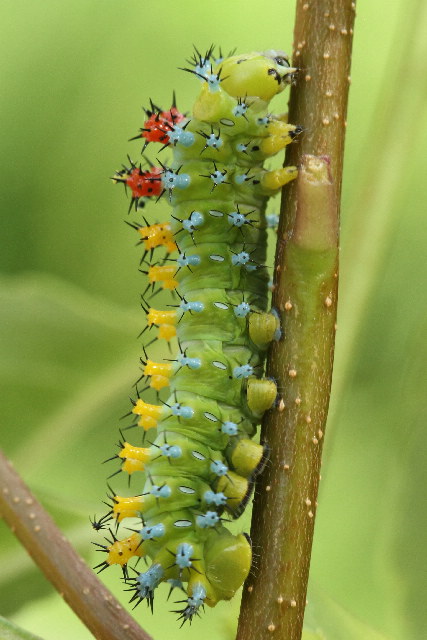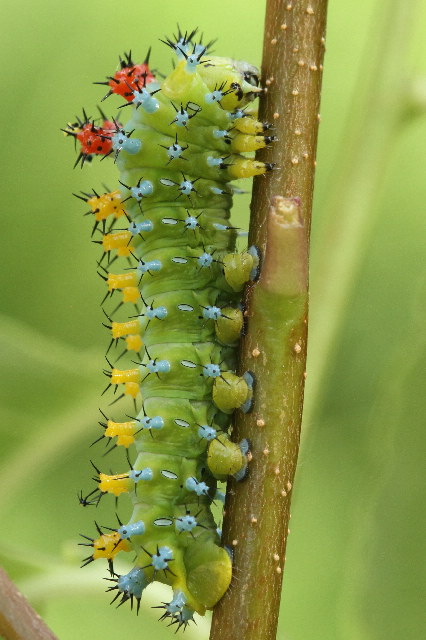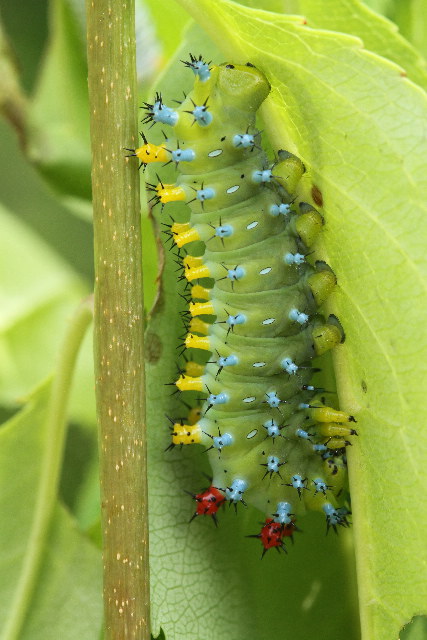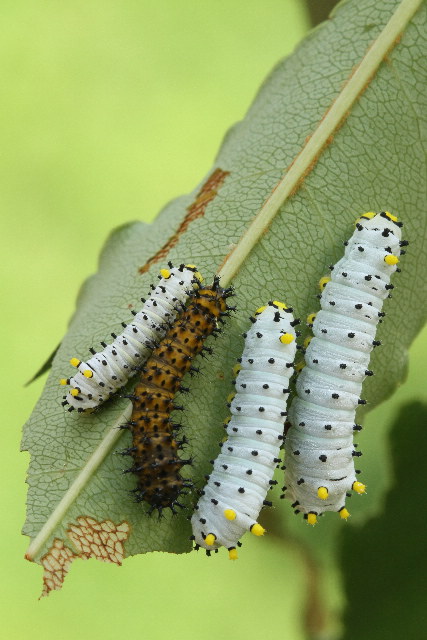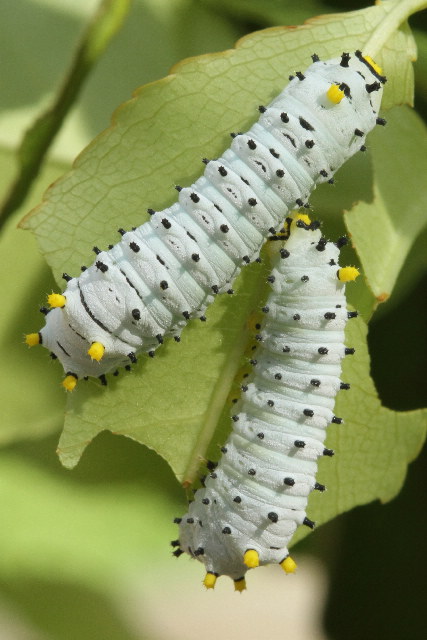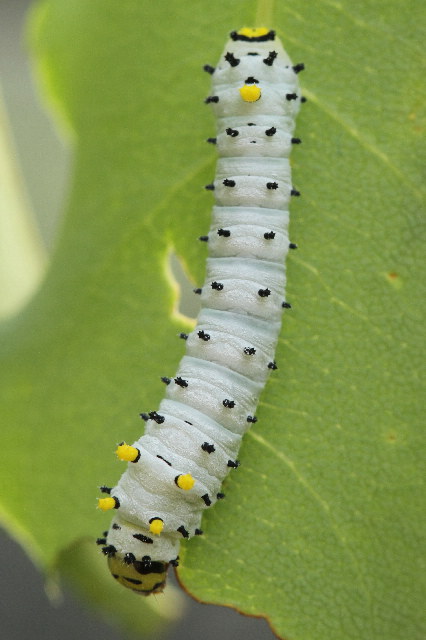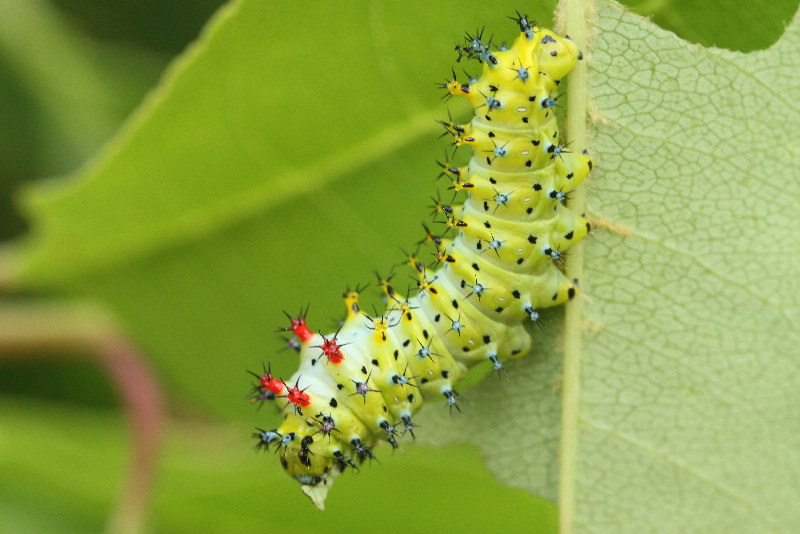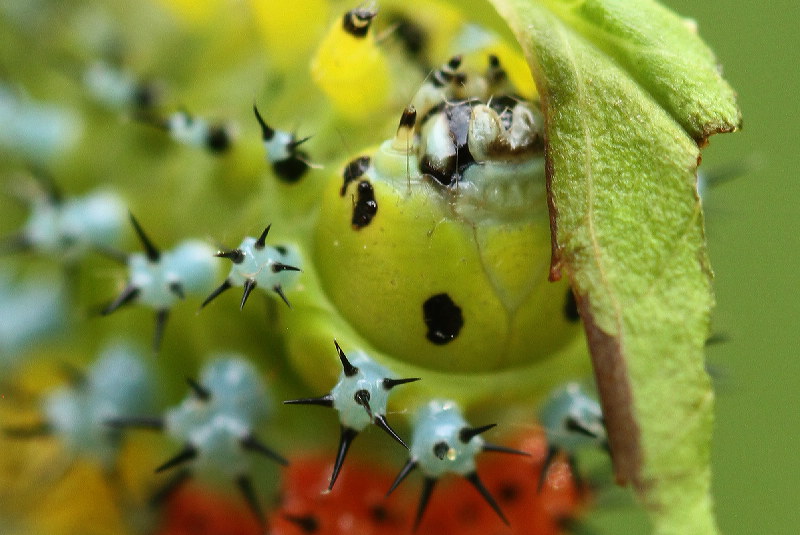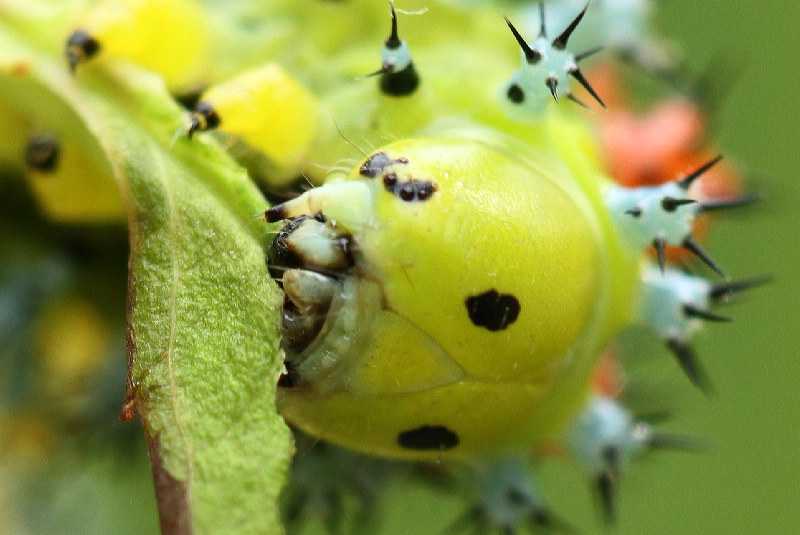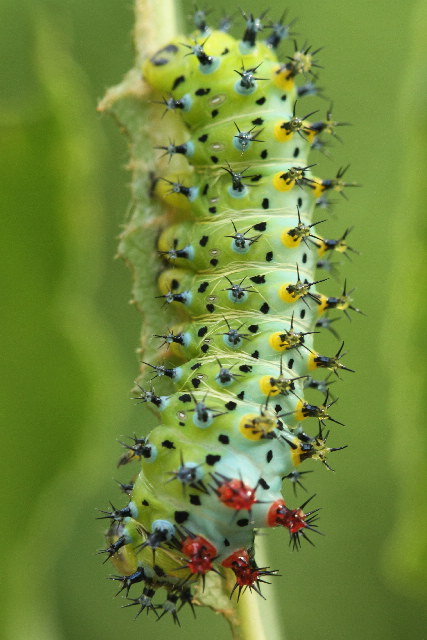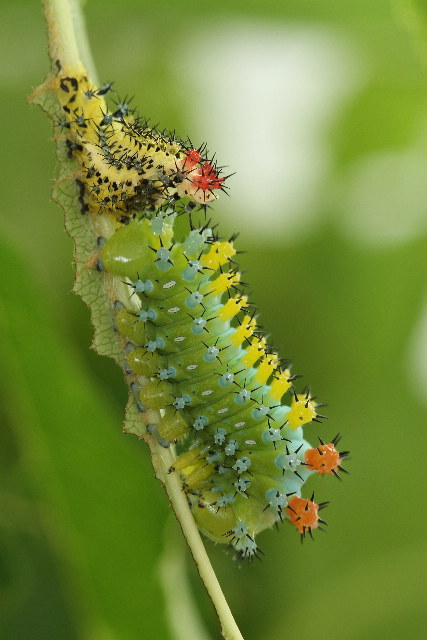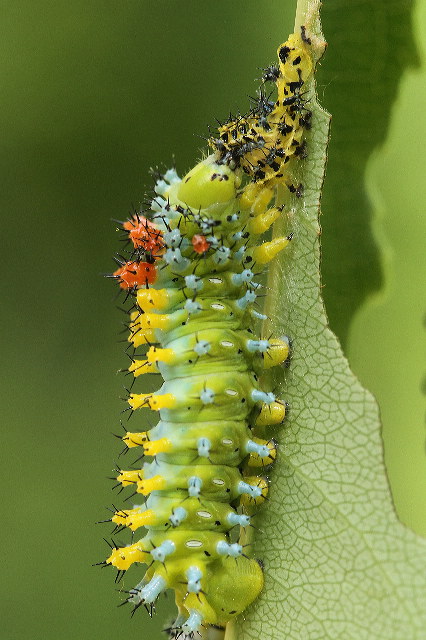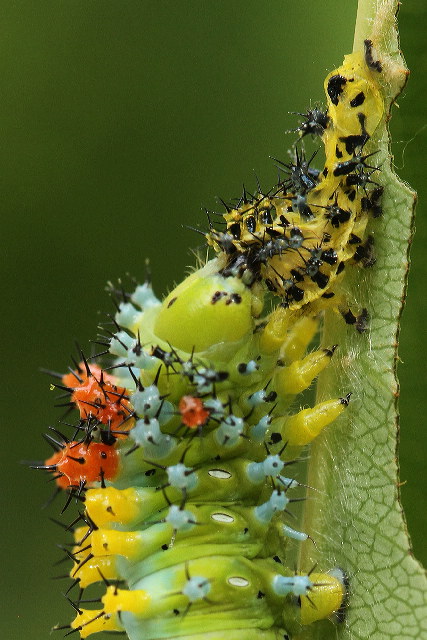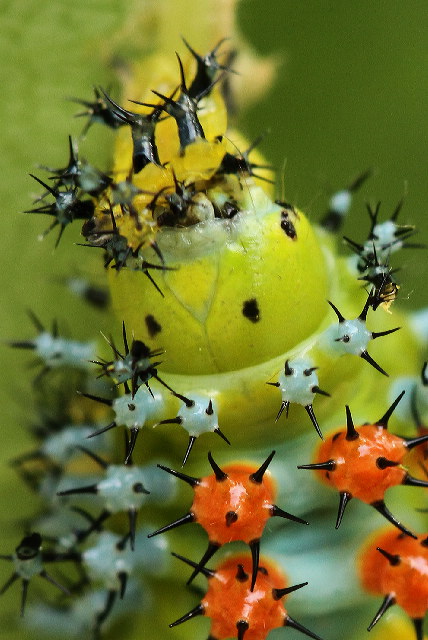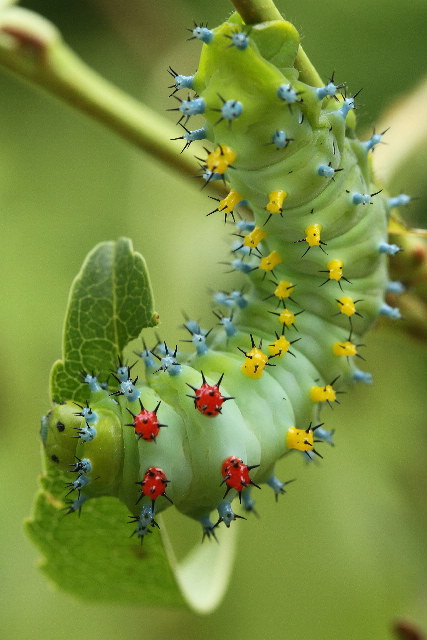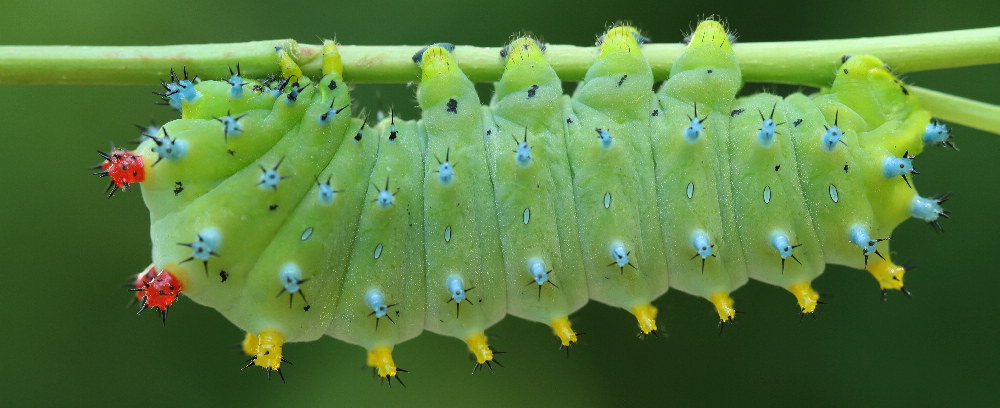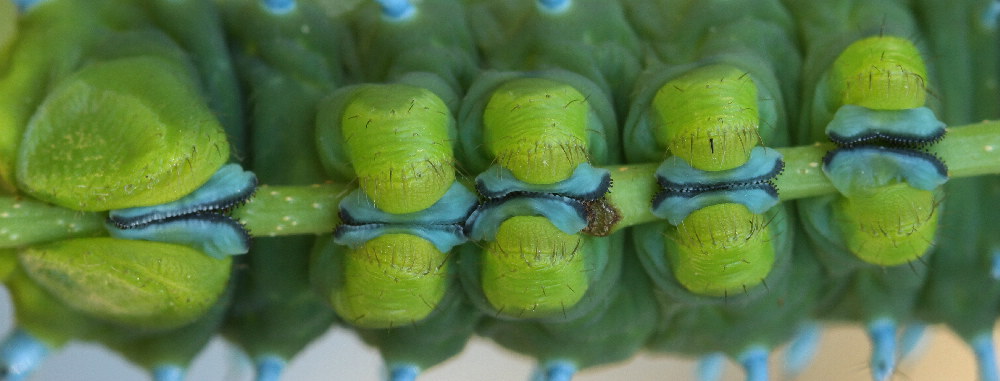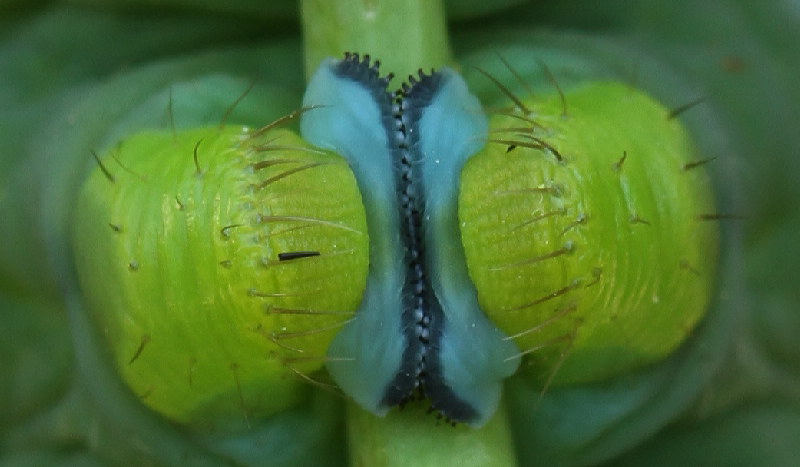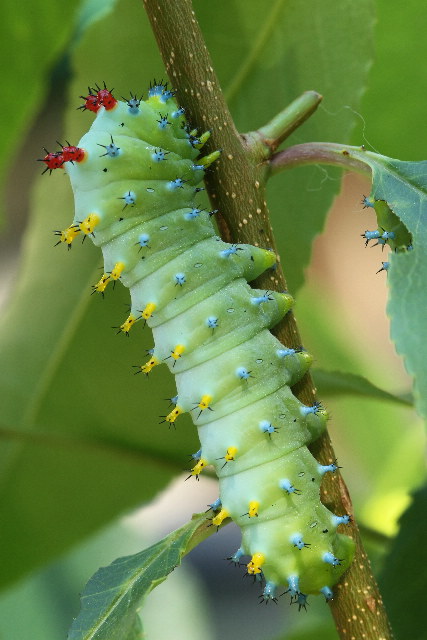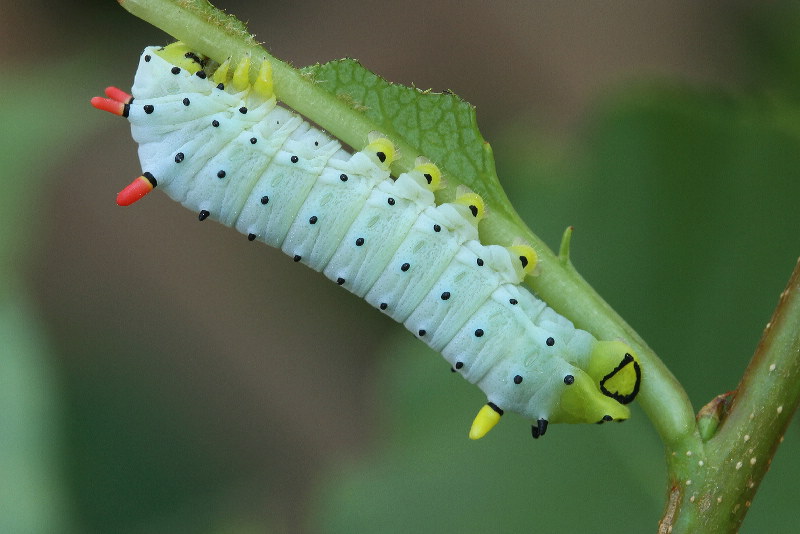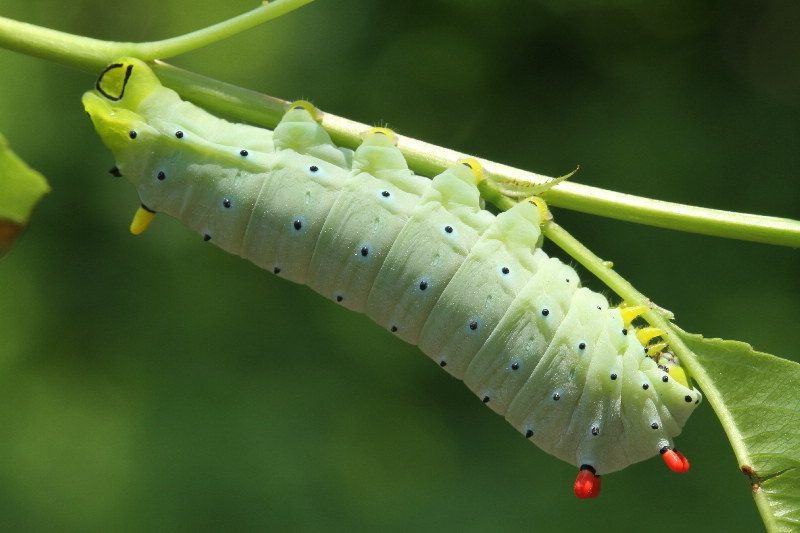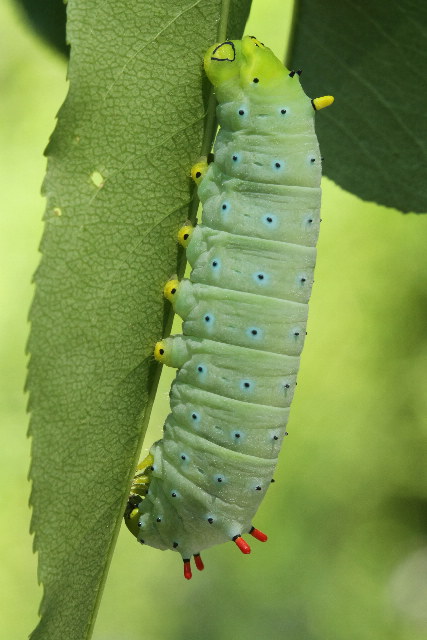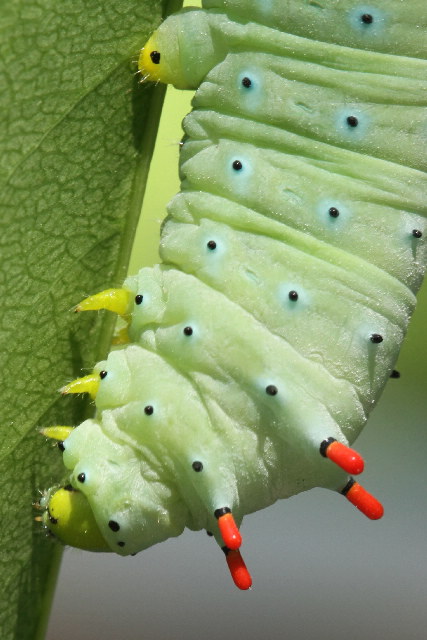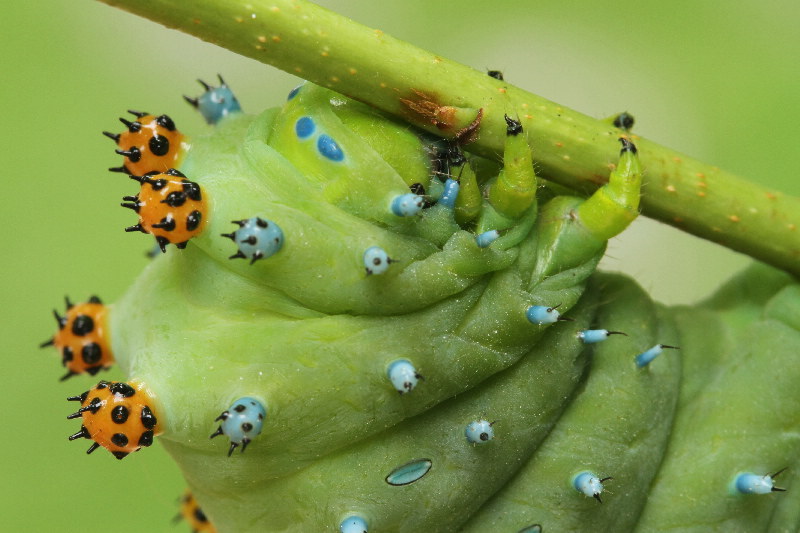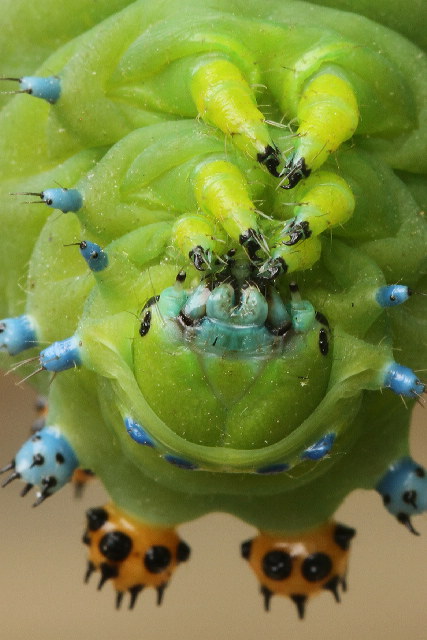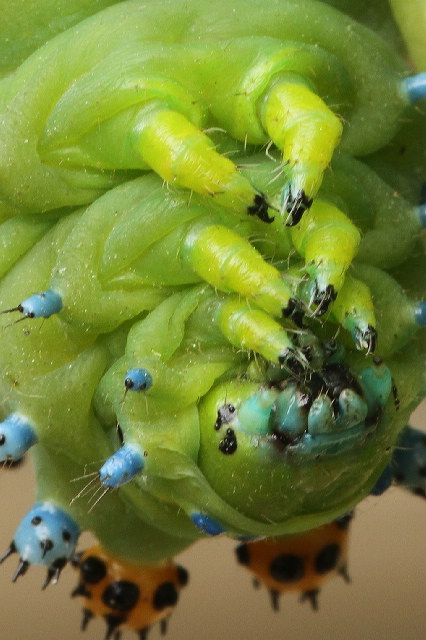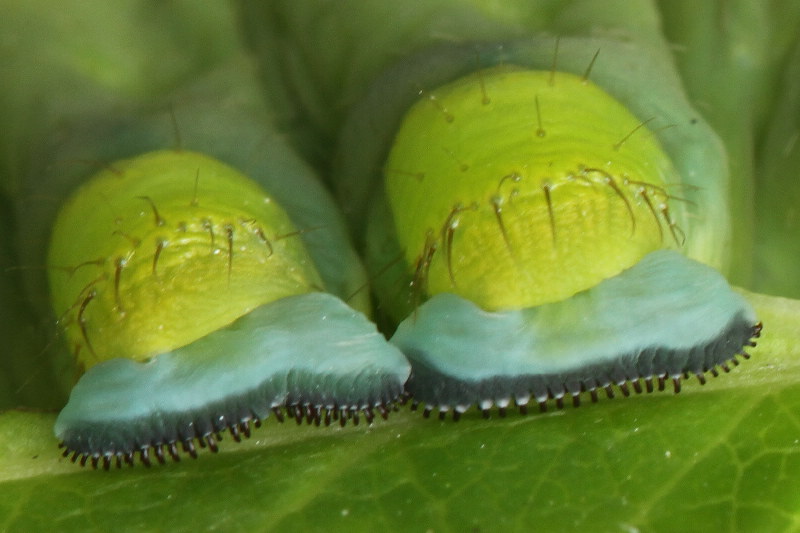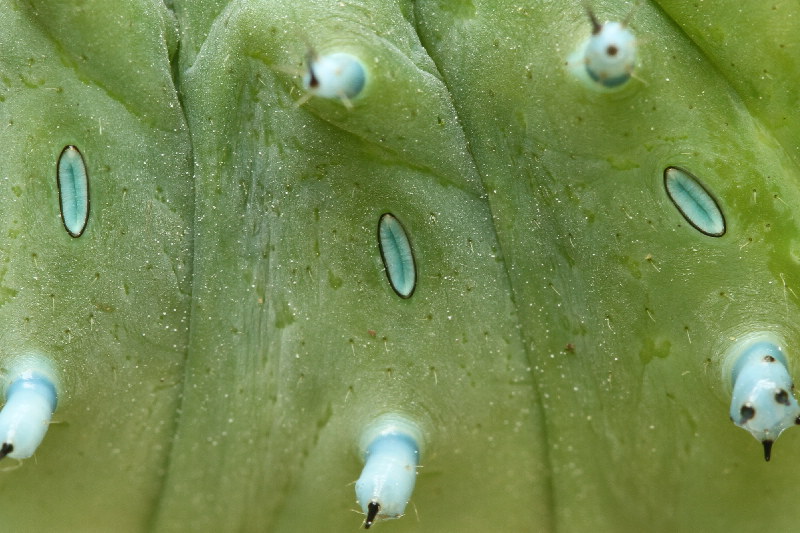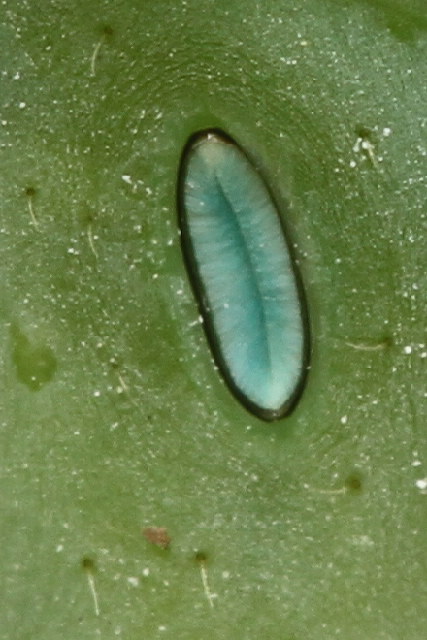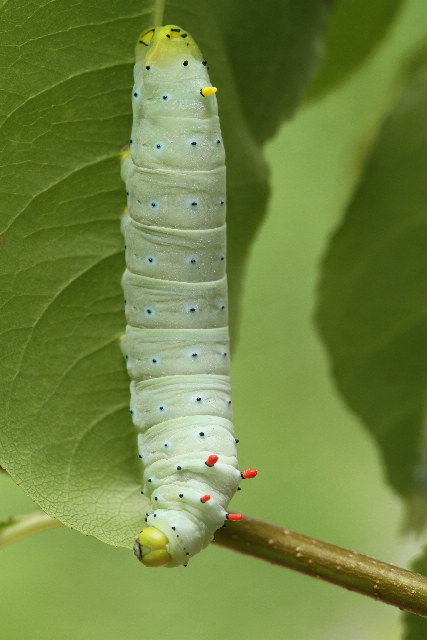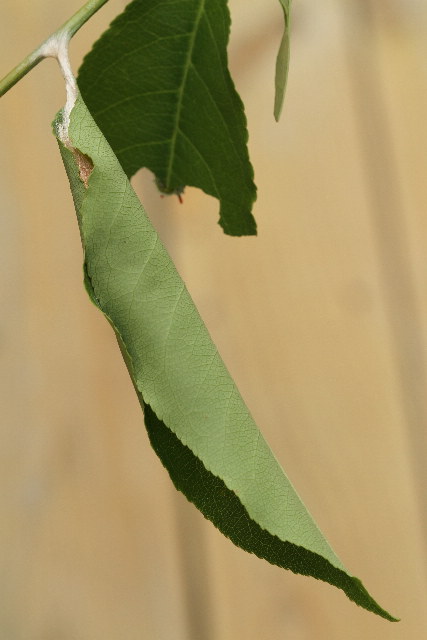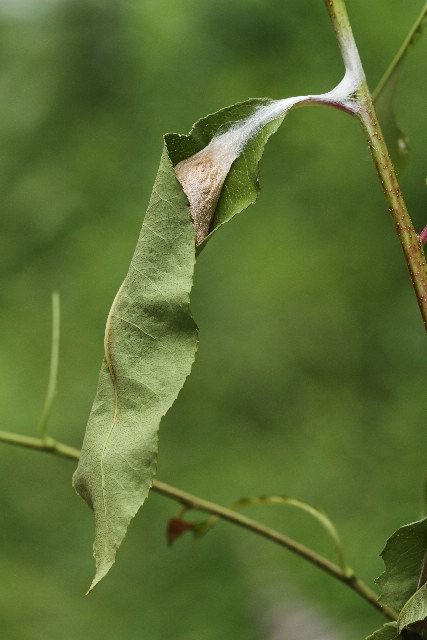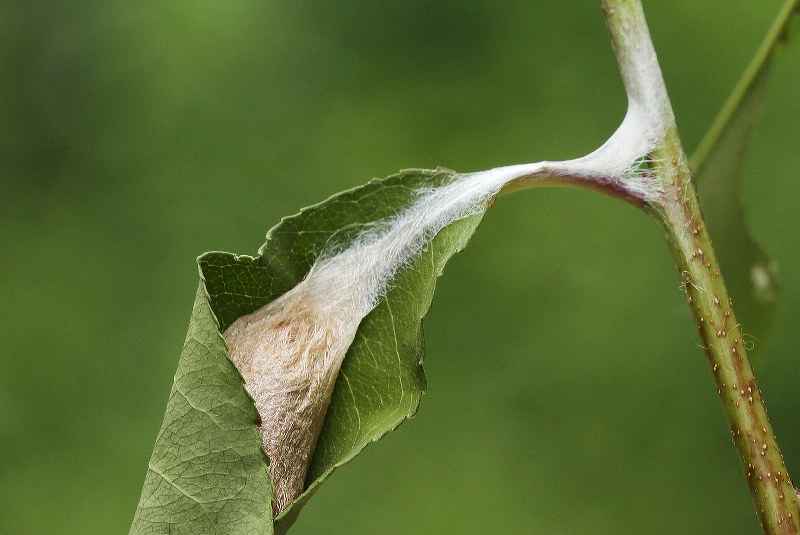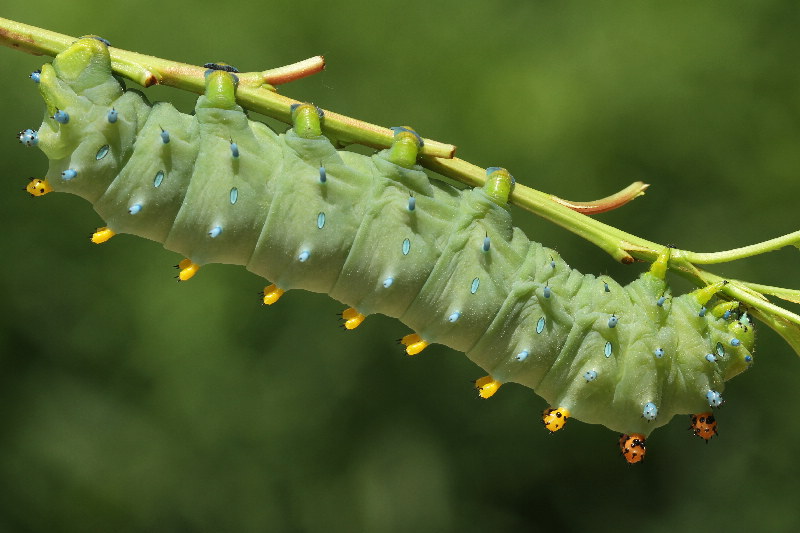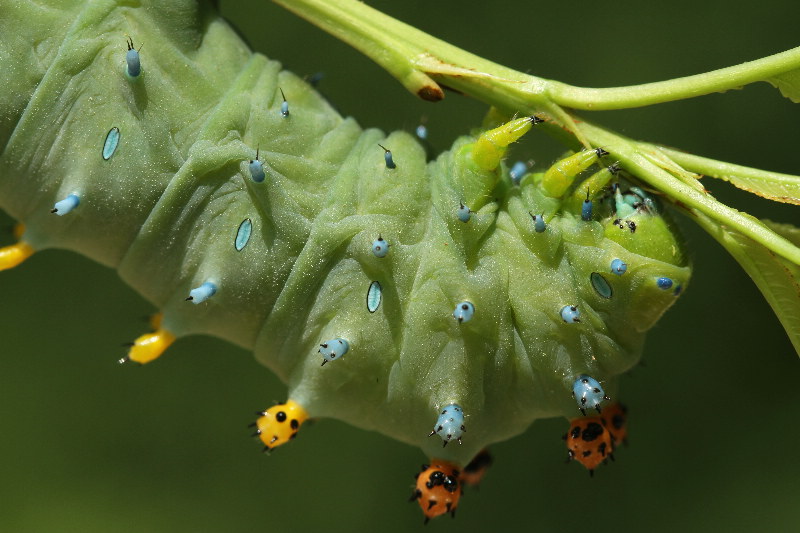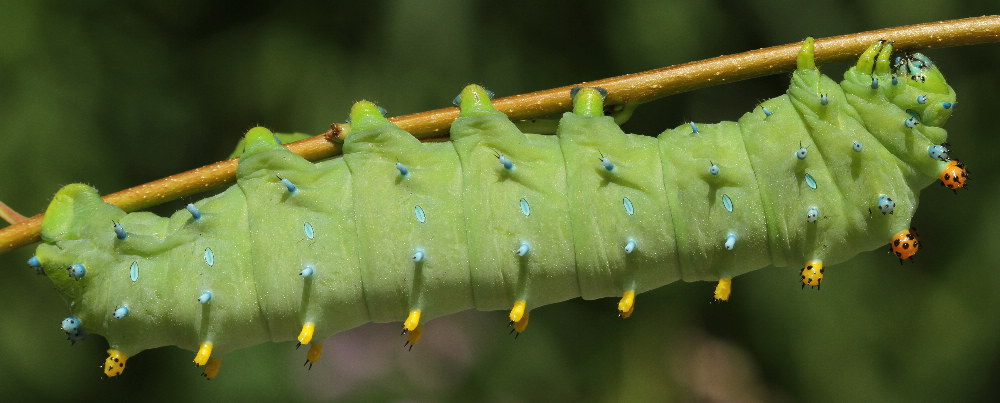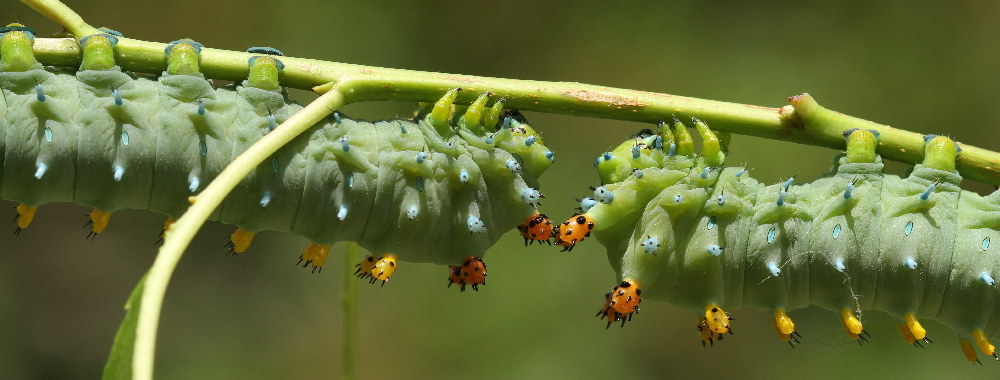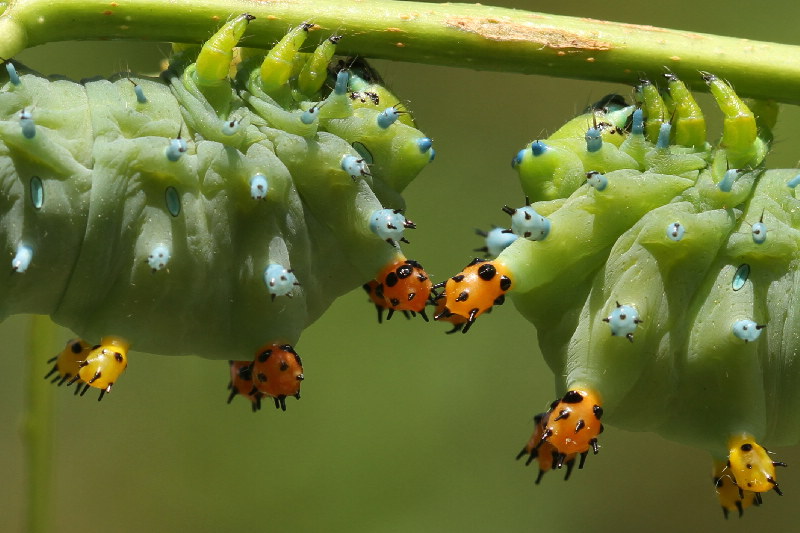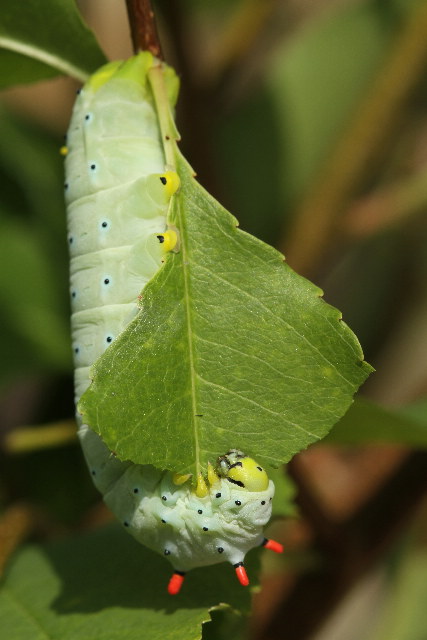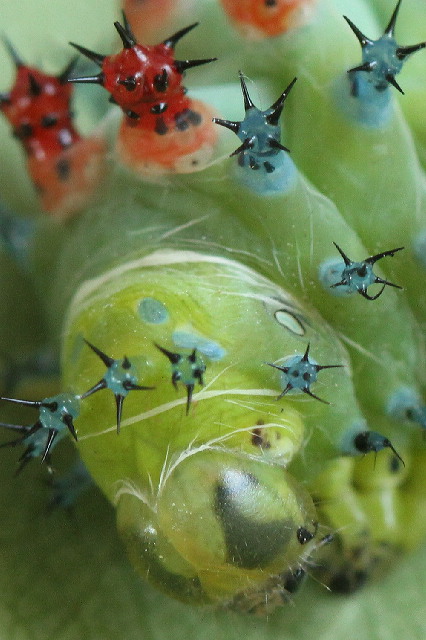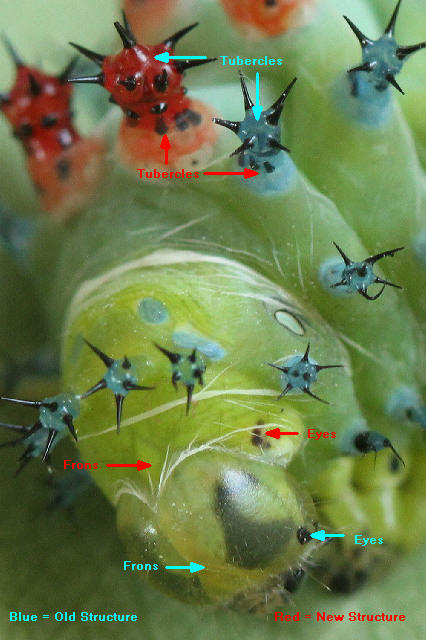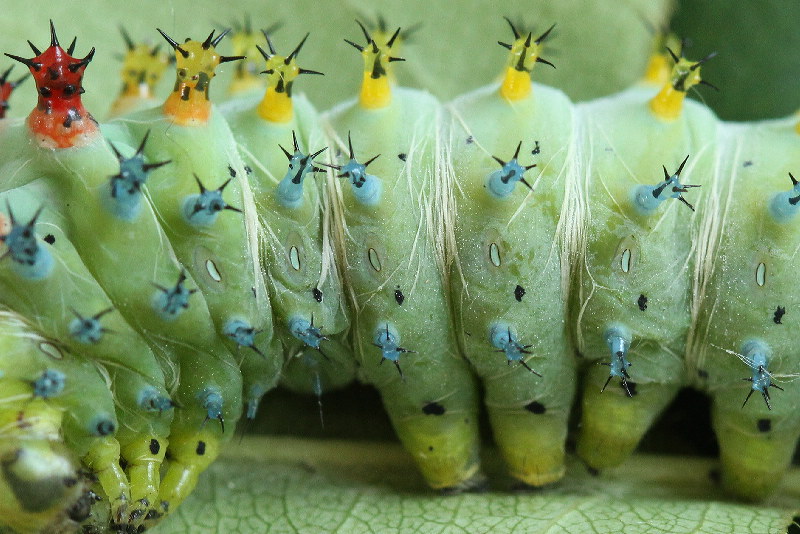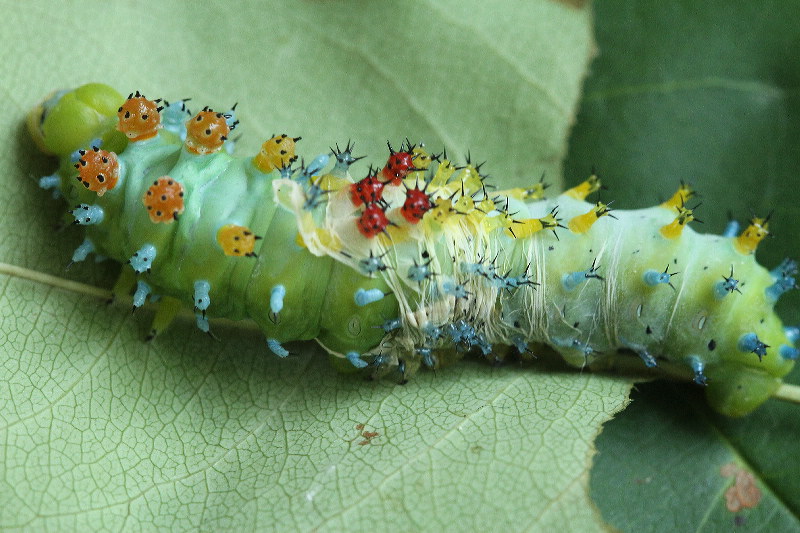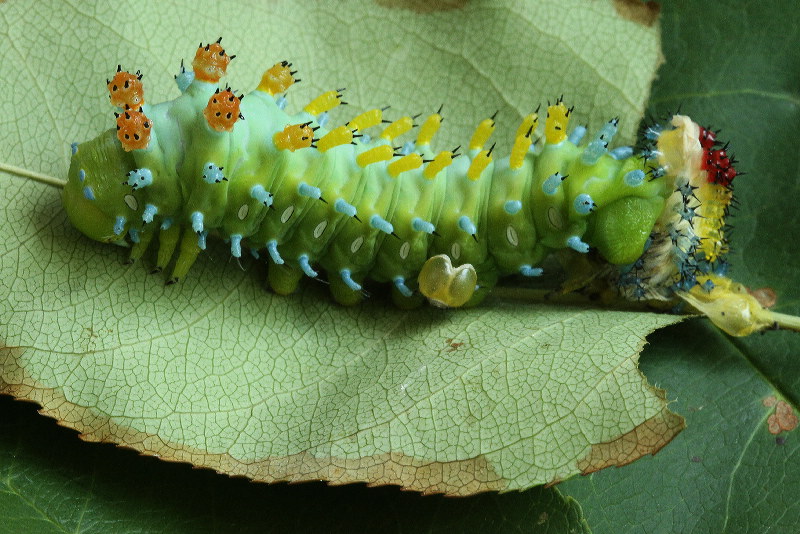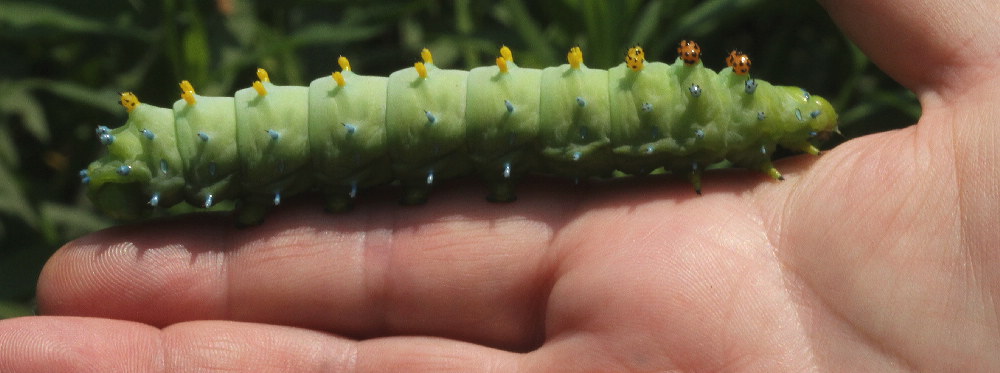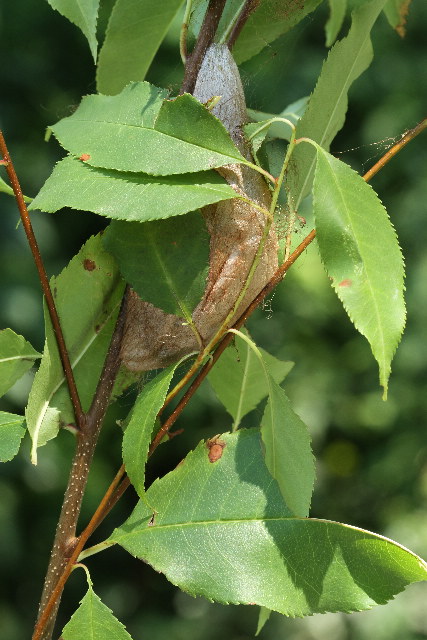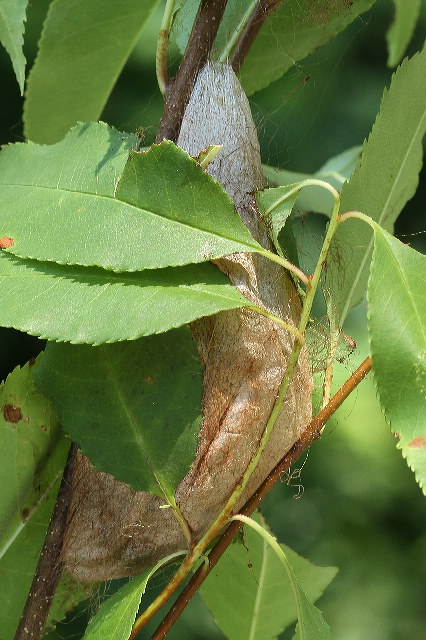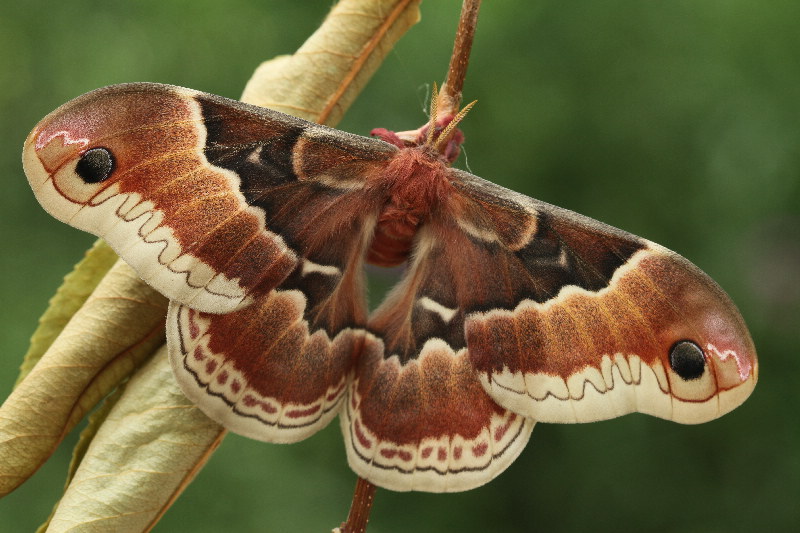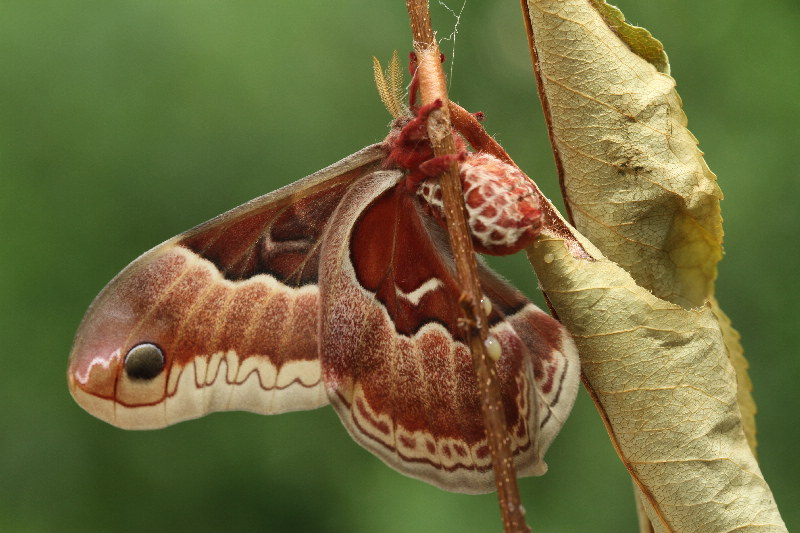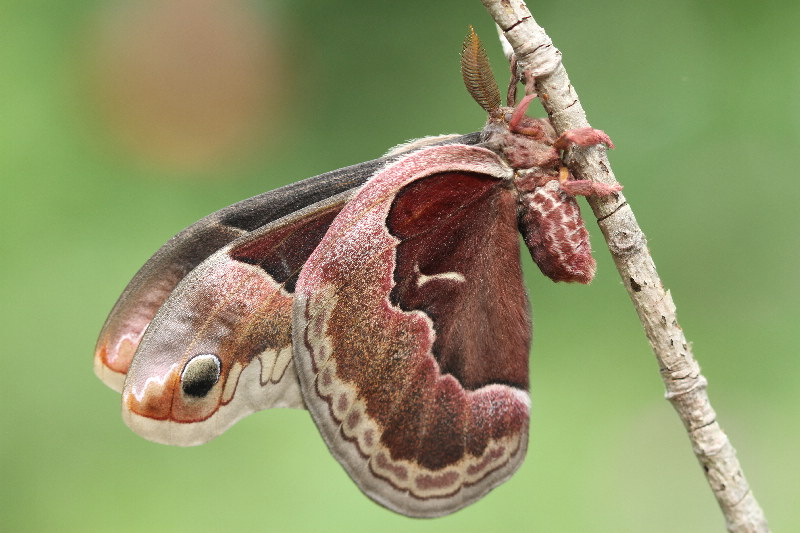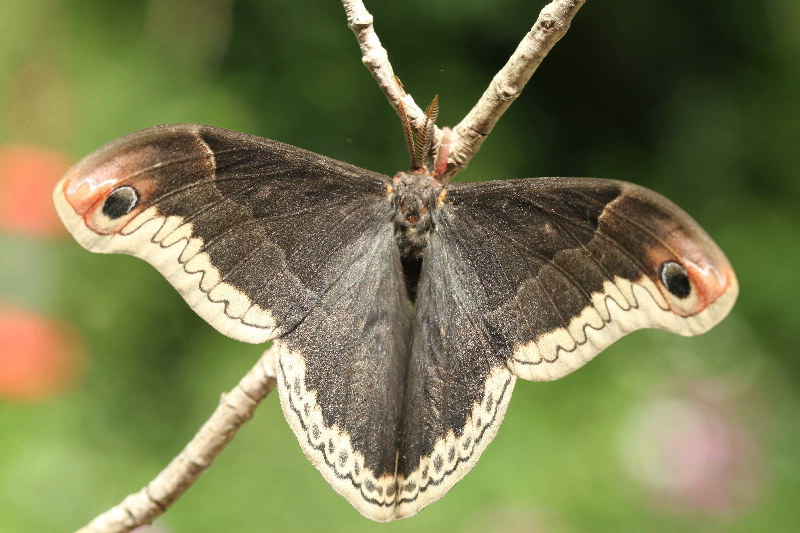Cecropia Moth (Hyalophora cecropia), Life Cycle 2011 Interspersed with Promethea Moth images as the two species were reared together. - Stan Malcolm Photos |
Cecropia Home Page Along the Air Line... |
May 23rd. The first adult, a female, emerged from its cocoon. After several days, it attracted and mated with a wild male. This year's Cecropia adults are the result of rearing caterpillars from eggs provided last spring by Jeremiah Compton of Wellsboro, Pennsylvania. |
Another female. This one emerged on June 5th and was also mated to a wild male. |
|
A male that emerged on June 8th. |
|
A female that emerged on June 8th. |
|
A close-up of the male. |
The first female laid eggs on or about May 27th. Typically, they were glued to the substrate in clusters of 3 to 8. |
Cecropia eggs were roughly 2.2mm long, as compared with these three Promethea eggs which were roughly 1.5mm long (but probably no more than 25% of the volume of the larger Cecropia eggs). |
June 13th. All the eggs hatched this morning. |
Larvae are from 5 to 7mm long, black and very spiny. |
Note the branched pale objects adhering to some of the spines. Could the caterpillars be shedding their skins immediately after exiting the egg - or perhaps even in the egg? (I've noticed these presumed exuvia on recently hatched Cecropia larvae for several years; they're not a fluke.) |
June 28th. The caterpillars have grown substantially and have diverged: some have molted and are considerable larger than those that haven't. |
|
As the get ready to molt, their skin loses much of its black color. |
After molting, the skin is bright yellow and the tubercles are orange/red, yellow, and pale blue. |
A few tubercles near the head remain black. |
|
Munching on a cherry leaf, as in the following HD movie. |
|
A Cecropia caterpillar at left compared to some Promethea caterpillars which hatched a few days after the Cecropias. (Promethea caterpillars commonly line up to feed in their early stages.) |
|
|
July 4th. The caterpillars have grown a lot and are represented by at least three different instars. This is one of the larger ones. |
|
|
|
|
|
An early instar Cecropia caterpillar (yellow-brown) is flanked by larger Promethea caterpillars. Since all these caterpillars hatched within a couple of days of each other, you can see that growth rates vary widely between individuals. |
Compared to my June 28th photos, the Promethea caterpillars have lost their black stripes and acquired a pale waxy coating. |
|
I enjoy watching caterpillars eat; they're very methodical and waste little. |
|
A close-up of the mouthparts. In this inverted view, you can see that the Labrum (upper lip) is grooved and serves to guide feeding on the edge of a leaf. |
The caterpillar's simple eyes (Ocelli) are the row of black bumps on the side close to the mouthparts. What appear to be eyes (oval black spots) are simply pigment. |
This caterpillar is about to molt. You can see where the old skin has begun to separate from the new skin underneath. |
The same caterpillar a few minutes later with the old skin clinging to the leaf behind the caterpillar. The orange tubercles on the new skin will darken to red in a day or so. |
A different caterpillar that had just molted turned to eat the cast skin, thus recycling the materials in it. |
|
|
|
The largest of the cecropia caterpillars. |
July 10th. The Cecropia caterpillars still span a wide range of sizes but are generally much larger. |
Some are brutes. |
Abdominal pro-legs attach to leaves and twigs using what amounts to velcro hooks, seen here in blue. Pro-legs are not true legs: insects have 3 pair of true legs on the thorax only. |
|
|
The Promethea caterpillars are also maturing. |
Watch this one "moonwalking" backwards, then feeding on a leaf's midrib. |
|
Several larger Promethea caterpillars. As they mature, they lose much of the pale waxy bloom, becoming much greener. |
I think some will begin spinning cocoons within a week. |
This photo shows the Promethea caterpillar's yellow thoracic true legs. |
July 13th. Some of the Cecropia caterpillars are truly massive, approaching 4" long and as thick as a finger. Cocoons soon! |
|
A few details, starting with the head, thorax, and true legs. |
|
|
"Crochets" that anchor the abdominal prolegs to the substrate. |
Three abdominal spiracles, gateways to the tracheal tubes that deliver air directly to the body tissues. |
A single spiracle. The entry slit is held closed most of the time, presumably to prevent dessication. |
Many of the Promethea caterpillars have matured. |
|
One of the first five Promethea cocoons, spun last night. |
Another. |
Note how the leaf is secured to the stem with silk so that the cocoon doesn't fall to the ground in autumn. |
Time Lapse video of early stages of Promethea cocoon construction. |
July 16th. The largest Cecropia caterpillars are in the 7.5 to 9 centimeter range. |
|
|
No photo can convey the mass of these creatures. They have weight. They have "presence". They have a singlmindedness of purpose: to eat, to grow, and soon to spin! |
Which will yield? They remind me of a "cornfield meet" as was staged at the Iowa State Fair in 1896 and at other venues well into the 20th Century. |
Squaring off... to rest for awhile. When they're ready, they'll pass by peacefully. |
New Promethea cocoons daily, and most of the rest are nearly full grown. |
|
July 19th. This Cecropia caterpillar is about to molt to the final larval instar. The old skin is loose and starting to wrinkle (the light lines). |
The new structures have begun pulling away from the old ones as you can see in this labeled view. The old head capsule is pushed forward from the new one (the Frons is a plate on the front of the head); and the old tubercles are pushed up from the new, larger ones. |
Here you can see how thin and wrinkled the old skin has become. Much of its substance has been reabsorbed and recycled into the new skin (the rest is typically eaten and thus recycled too.) In the video, below, you can watch the abdominal segments flexing to further loosen the old skin. |
Finally, the skin splits behind the head capsule and shrinks back as the caterpillar pulses its body to squeeze forward. |
The head capsule (seen here stuck to the side of the body) was scraped free as the caterpiller swung its head side to side. At this point, the caterpillar had just pushed entirely free of the old skin. |
Now watch the process in full HD video. |
July 20th. At over 10 centimeters (four inches), this caterpillar is full grown and on the move, looking for a suitable spot to construct a cocoon. |
July 30th. Cecropia caterpillars have been spinning cocoons for several weeks now. (I'm pretty sure the last Promethea caterpillar spun yesterday.) |
This cocoon is still fresh. It will darken over time. The caterpillar has not yet completed the inner layer which it must do before transforming into a pupa. The lighter colored silk at the top is the one-way channel through which the adult moth will emerge next May. Once out, it will expand its wings and be ready to fly several hours later. |
August 9th. A female Promethea emerged this morning. Three males have emerged in the past four days, the vanguard of a second brood that will be lucky to make the cocoon stage before the last leaves fall. |
As of this date, I have 36 Cecropia cocoons and 5 remaining caterpillars. All should overwinter and emerge next May. I also have 51 Promethea cocoons from which 4 adults have already emerged. Based on last year's experience, I expect roughly half the adults will emerge in the next several weeks; the rest will overwinter. |
I also have one Luna Moth cocoon spun last night by a caterpillar found crawling on the Air Line Trail yesterday. |
August 11th. A male and female Promethea emerged today. Here are two photos of the male. |
Males differ primarily in their dark upper surfaces. They tend to fly fast in mid- to late afternoon, and could well be part of the dark swallowtail mimicry complex. So far, seven Prometheas have emerged; five males and two females. |
